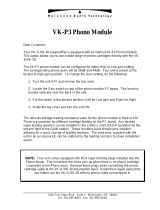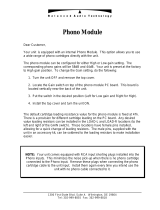Page is loading ...

1742 Selby Av.
St. Paul, MN 55104
651-690-2246
atma-sphere.com
Atma-Sphere Music Preamplifier
model P-2
OWNER'S MANUAL
Please study this document carefully before using equipment
RoHS

CONGRATULATIONS!
You have purchased one of the world's finest preamplifiers and certainly one
of the most unique. Developed and refined since 1989 it is (at the time of
this writing) the only fully-differential balanced vacuum-tube preamp
technology in the world featuring a direct-coupled output. Thus it operates
at a level of performance that others have been struggling for years to
achieve, and likely will for years to come. You don't have to wait; all you
have to do is set the preamplifier up by following the simple instructions in
this manual.
Every part of the preamplifier has been extensively tested and engineered so
the product will perform flawlessly for years to come..
Please read the manual carefully and follow the instructions closely. If you
have any questions, do not hesitate to contact your dealer or Atma-Sphere
Music Systems, Inc. Here's to many years of happy listening!
Sincerely,
Ralph Karsten
Atma-Sphere Music Systems, Inc., 1742 Selby Av., St. Paul, MN 55104 651.690.2246

MUSIC PREAMPLIFIER SETUP AND OPERATION
Unpack the preamplifier carefully and save the packaging containers for
future shipment if required.
During operation, the P-2 gets warm. Adequate ventilation is mandatory. If
the preamplifier is to be placed in a shelf or rack mount system, allow for
at least 2 inches of open space above the unit. Make sure that the
preamplifier is at least a foot away from any power supply, to avoid hum
problems.
After the preamplifier is properly positioned, make sure that the power
switch is in the OFF position. Connect the cables for the various components
to be used with the preamplifier.
For superior sonic performance, the P-2 does not use a muting circuit. Allow
the preamplifier to warm up and stabilize before energizing your power
amplifiers.
WARNING! DO NOT TURN ON THE AMPLIFIERS IN YOUR SYSTEM UNTIL THE PREAMPLIFIER
IS WARMED UP AND STABILIZED! DAMAGE TO SPEAKERS, AMPLIFIERS OR BOTH MAY
RESULT!
Get in the habit of turning down the volume or switching to an unused input
anytime you turn your amplifier on, when you change a record, etc.
After the preamplifier is turned on, it takes about 30 seconds before it is
ready for use. The preamplifier will sound significantly better after about
45 minutes of operation.
OPERATING NOTES
The preamplifier can be left on all the time, but the phono tubes should be
tested every 4 months if you do so. The line stage tubes will last
considerably longer! Be sure to provide for adequate ventilation. The unit
will sound substantially better an hour after turn-on, so leaving the preamp
on all the time will not win you anything.
The P-2 may be used with a low impedance (600 ohm) load at the input of the
power amplifier which can be used to reduce hum, buzz and interconnect cable
artifact. If you do not have a 600 ohm input on the amplifiers, install a 600
ohm (or similar value, up to 1000 ohm, both channels should get the same
value) ½ watt resistor between pin 2 and pin 3 of the output XLRs of each
channel. This will result in significantly better sound!
The GAIN TRIM is provided to adjust for proper left-right balance effect and
to allow for range on the volume control. The P-2 is a zero feedback design
so tube condition can cause a gain difference between left and right
channels. Operate the control SLOWLY. The GAIN TRIM controls are not in the
audio path. They may generate a temporary DC offset (and sometimes noise)
when they are operated. This can be reduced or eliminated depending on the
balance of the sections in the 12AU7 (or 12AT7, in later units with the 3-
tube line section) used in the high level section.
Due to the nature of the P-2, expensive cables between the preamplifier and

power amplifier are not needed. The cable differences you hear will be minor
compared to single-ended cables. Thus we have no recommendation for cables to
be used between the preamplifier and power amplifier. On the other hand, the
input cables may be very critical, depending on the source.
PHONOGRAPH HOOKUP
All phonograph cartridges (except some old-style Deccas) are balanced
sources. The P-2 allows you to set up your turntable as a fully-balanced
source, to considerable sonic advantage. For best results, follow the
connection scheme outlined below:
1) Use a cable that has two signal conductors (twisted pair) PLUS a shield
for each channel. The two conductors are for the plus and minus outputs of
the cartridge, and the shield connection becomes the tone arm/turntable
ground connection and is common to BOTH channels.
2) Pin number 1 of any XLR connection is always be ground per industry
standard.
3) Pin two of the XLR phono input corresponds to the "+" or non-inverting
output of the cartridge, and pin three is the "-" or inverting output of the
cartridge. Absolute system phase can be corrected from the front panel.
4) There is no need for an independent ground wire from the arm to the preamp.
If you set up the cable correctly, there will be no hum. Many tone arms use a five pin
connector that plugs into the bottom of the arm. If this is the case in your system,
you may order a tone arm cable with the right connections from almost any cable
manufacturer. If your arm has RCA connectors at the output, an adapter cable can be
made that will work. The shield connection of the RCA must become the connection to
pin 3 of the XLR connector, and the tone arm ground connection should be made as
described above. ON NO ACCOUNT should you allow the shield connection of the RCA to
become the shield for the cable, as this may result in a loud hum.
Cartridge loading is achieved by installing resistors on the loading terminal on the
rear panel. A screwdriver is all that is needed for attachment. You will have to
experiment to obtain the correct value. The stock loading value is 47KOhms.
Avoid using NOS 12AT7s in the P-2. Despite frequent claims to the contrary, most such
tubes are far too noisy for proper operation in the P-2! Please purchase new 12AT7s
from your dealer or Atma-Sphere Music Systems, Inc.. Most 12AT7s tend to get noisy
after about 3 thousand hours so; if you leave the preamp on 24 hours a day the phono
tubes should be replaced every 3-4 months. They will last longer if the preamp is
turned off when not in use. In any event, be VERY suspicious of any NOS 12AT7s. Most
of them are unacceptable.
For very low output cartridges you may wish to have the step-up transformer option
installed. Contact your dealer for details.
High-Level Hookup
The auxiliary inputs are high impedance. Thus you may use any input as a
source for the P-2. If you are using a low impedance source, a low impedance
termination is recommended for better sound. A single-ended source can also
be used, by applying the signal between either pin two or pin three of the
input XLR, and ground. The unused input (pin three or pin two, respectively),
may have to be shorted out to prevent noise. Pin two of all the XLR inputs is

the non-inverting input, per industry standard.
The tape outputs are high impedance. Use a high quality cable for best
results and keep the cable as short as possible. The minimum drive impedance
is 20Kohms. The tape 2 output is inverted while tape 1 is non-inverted.
The tape monitors are a single-ended, non-inverting, high impedance input.
NOTES ON TUBES
1) The 12AT7s in the rear left of the board are the most critical for low
noise phono operation.
2) The constant current source tube (the 7th 12AT7 by itself in the rear) is
outside of the signal path. It should not be Chinese.
3) Matched sections in the 12AU7s of the high level section will
reduce DC offset during operation of the front panel GAIN TRIM controls.
4) Tube damping rings are recommended.
5) Do not remove tubes while unit is operating. Hazardous or lethal voltages
are present!
6) NEVER use Tweek, Pro-Gold or other contact enhancers on vacuum tubes!!
7) Long live analog!
TROUBLESHOOTING TIPS
Bottom front panel LED won't light up: Check the rear panel AC connector and
verify that the power cord is plugged in. If so, the internal 1.5Amp SLOW
BLOW (.75A if 235 Volts) fuse may be blown.
Buzz, hum and/or RF interference: Make sure that the power cord is plugged
into a properly grounded outlet and that no other equipment in the system is
grounded (resulting in a ground loop). Sometimes RF can get into the
phonograph through poorly shielded wiring in or from the tone arm. This is
common with modern straight-tracking arms. Buzz can also occur if the input
of the amplifier is not properly balanced. This can occur if the amplifier
has an RF filter at its input that is only active on the non-inverting input.
There are quite a few transistor amps with balanced inputs that are set up
this way.
Distortion: Check the output tube (12AU7 or 12AT7) for defects.
Ringing or 'bell' sound when operating volume (microphonics): Usually the
tubes in the line stage is the most likely to cause this fault. The 12AT7s in
the phono section can do this too. If the P-2 is OK on AUX inputs, but rings
on the phono, then the phono 12AT7s are most likely at fault.
**DO NOT USE CONTACT ENHANCERS ON THE TUBE SOCKETS!!**
If none of these suggestions help, please contact your dealer or Atma-Sphere
Music Systems, Inc.
MORE TIPS AND TWEAKS
You can reduce the noise level beyond the specification by using low noise tubes. When
ordering from any source, specify tubes for a differential circuit (matched tube
sections). We have found that the 12AT7 at the input of the phonograph is the most
audible.

We recommend line conditioning. The fifth harmonic of the power line frequency has
been shown to be far more problematic for good sound then all other types of power
line problems (RF, spikes, etc.) put together.
We have found that the power cord can have audible effects! A good cable is
recommended.
The Sound Anchors equipment stand is one of the finest we have seen. It is highly
recommended. Use it in conjunction with the Ultra Resolution Technologies vibration
damping platform. NavCom Silencers or other anti-vibration pads are also recommended.
Tube damping rings are highly recommended.
The preamplifier has been successful with lower outputs (0.24mV) but it is advisable
to have the regulator option, and one must keep an eye on the condition of the phono
tubes for best results. A step-up MC transformer option is also available.
NOTES
/






